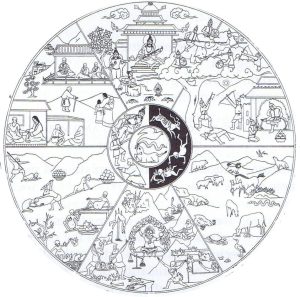17 Buddhist Cosmology
In Buddhism, as in many religions of the world, views about the universe and the place of humanity in it are essential for understanding how the religion solves the problems of life. Buddhism accepts certain ideas about cosmology that are common to other religions of India. These ideas include rebirth in samsara based on actions in the past.
Samsara
Samsara literally means wandering through the cycle of birth and death. There are six rebirth destinations in which beings are reborn based on their previous actions. Samsara is considered to be beginningless, and it ends only for those who follow the path to nirvana. The six realms are:
- Heaven: the realm of the gods and other spiritual beings whose who actions were predominantly good. Heaven, being part of samsara is a temporary destination. Once the Karma that resulted in rebirth in heaven is exhausted, one is reborn in one of the other, lower rebirths.
- Titans or Heroes: the realm of heroes and great warriors.
- Human: the ideal realm for spiritual practice. Humans can reflect on their good and bad actions. They can see impermanence, suffering, and non-self (selflessness) in existence.
- Animal: just below humans, the animal realm is less fortunate, but is not excluded from Buddhist teachings.
- Hungry Ghosts: the destination of those who were not generous in life. They are always hungry and thirsty but cannot consume enough through their small throats to fill their large stomachs.
- Hell: the destination of those whose actions were predominantly bad. Hell, like heaven, is impermanent. When the karmic forces that resulted in rebirth in hell are exhausted, one is reborn in a different, higher realm.

In this typical diagram, the three realms above the horizontal line are considered to be fortunate; the three realms below the line are less fortunate. In the center of the circle the image of a pig, symbolizing ignorance; a rooster, symbolizing greed; and a snake, symbolizing hatred.
Karma
Karma means intentional actions that have good or bad results. Karma is a moral doctrine in Buddhism. A person’s mental intention and actions through body, speech and mind lead to either wholesome or unwholesome results. Karma is not “fate” in Buddhism because a person’s actions are volitional: a person chooses to do good or bad actions.
Notice that karma is a process: it refers to actions that have results. The process continues from moment to moment and from one lifetime to the next.
Rebirth
Karma has results in the future: either the next moment, within one lifetime, or across more than one lifetime. Intention is the main force behind karma. In Hinduism or Jainism, the individual atman or self takes a new body in the new life, but in Buddhism, there is no reincarnation of the soul or self into a new body. Instead, the force of intentional actions or karma creates the conditions of a new life.
Points to remember about Buddhist Cosmology
- Karma is not fate. It is intentional action.
- Karma creates future conditions within one life, or across one lifetime to another.
- There is no “reincarnation” in Buddhist thought since there is no permanent immaterial “self” to take a new body.
This outline of Buddhist cosmology highlights how human action and intention are embedded in the realms of rebirth called samsara. As Buddhism developed, new ideas of cosmology began to emerge. In the section on Mahāyāna Buddhism you will see that ideas of the Buddha as eternal and the interdependence of nirvana and samsara begin to shift views of cosmology. In addition, Buddhists developed the idea of Buddha lands that were created by the fulfillment of a Buddha’s vows. Being reborn in such a “pure land” would make it that much easier to achieve enlightenment. These new conceptions of Buddhist cosmology grew out of ideas that were present in early Buddhism and demonstrate the internal diversity of Buddhist ideas.
